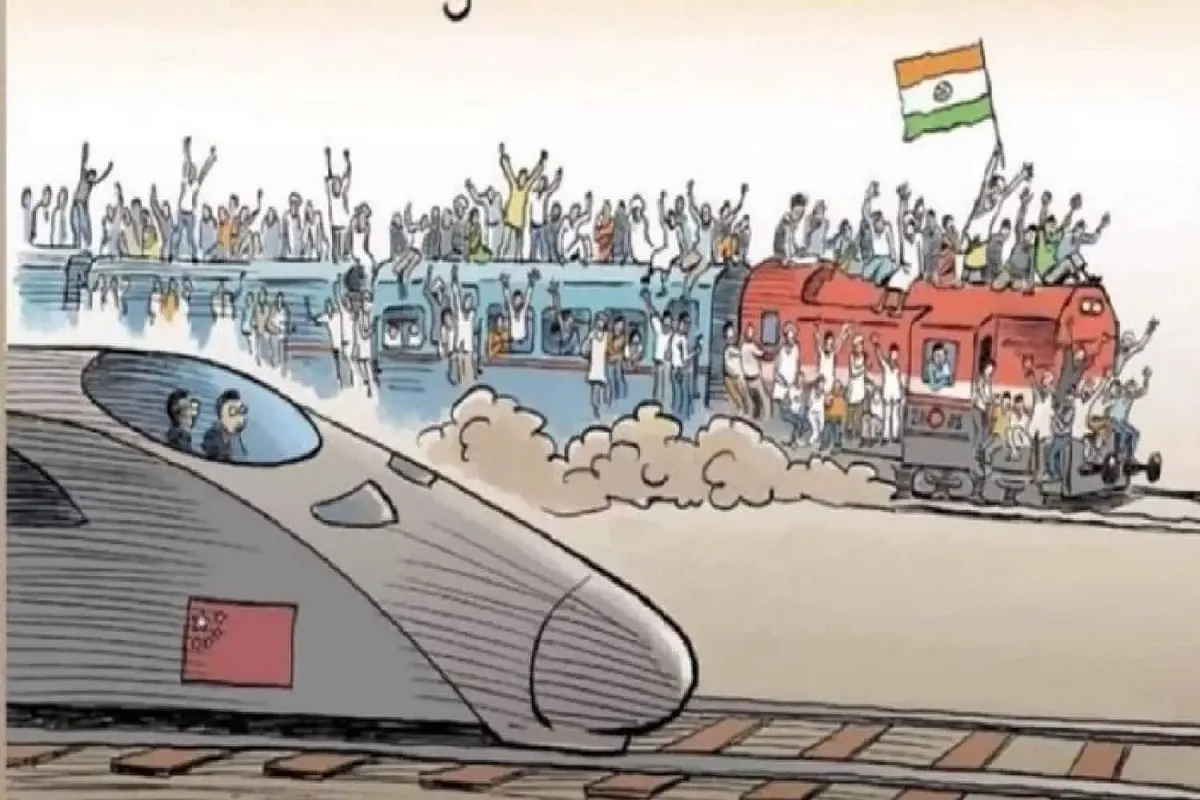
Der Spiegel's controversial cartoon
German magazine Der Spiegel has published a cartoon making fun of Indians. Through this cartoon, sarcasm has been made on India leaving behind China to become number one in terms of population, that India is still very backward while China has made a lot of progress. The cartoon maker has taken the train as a symbol. The cartoon shows a dilapidated Indian train full of passengers both inside and on top, overtaking a Chinese bullet train on a parallel track. The reference is to how India’s infrastructure is crumbling with its increasing population as compared to China.
From politicians to bureaucrats and common citizens of India are reacting strongly to this cartoon insult from Germany. Of course, overcrowded trains can still be seen in many parts of India, but the transformation of the country’s railway network and trains with significant and far-sighted investments in the last few years has set an example for many countries in the world. In such a situation, this cartoon clearly shows their cunningness of being ignorant or deliberately ignorant about the development of India. In today’s digital era, every piece of information is available online and any investigation will tell that about 85 percent of Indian Railways network has been completely electrified. In many states, the target of 100 per cent electrification in a broad gauge network has already been achieved. Despite this, this audacity of the so-called developed world would be called ridiculous.
The big talk and small acts of the developed world in the context of India have exposed their hypocrisy before. In 2015, the New York Times published a cartoon depicting India as an elephant sitting on the track in front of a train to the Paris climate conference. The train shown in the cartoon was also fitted with a coal engine, which is a symbol of carbon emissions. The New York Times was trying to say through the cartoon that India is responsible for carbon emissions, while the truth was that during the industrial revolution, western countries exploited the environment the most and later started blaming the developing countries.
But without playing the victim card, India has strongly demanded in fora like COP26 that it is the responsibility of the developed world to provide climate finance and technology transfer to the developing world to deal with the issue of climate change. But have developed countries cooperated in this? Not only this, the New York Times had earlier in 2014 made fun of India’s Mars mission. Although it had to apologize after the complaints of the readers, but the very next year the cartoon related to the Paris Summit shows that the West’s corrupt thinking of despising developing countries like India is deep-rooted. Interestingly, Der Spiegel magazine has also published a cartoon of the then US President Donald Trump beheading the Statue of Liberty.
In fact, Europe has started feeling insecure in a way, especially in the era of decreasing global influence and in the era of the Russia-Ukraine war. In recent times, many steps and statements of France and England have also been affected by this feeling of insecurity. Coming to Germany, despite several warnings at home and being Europe’s largest economy, has accepted to be a puppet of China. In fact, after the Russian invasion of Ukraine, its dependence on Russia for gas has proved to be a major weakness. This realization has forced the German government to rethink its relationship with China.
Despite all the American efforts to isolate China from the world and Germany’s claim to be a close friend of America, about 5000 German companies are doing business in China today. About 3 percent of Germany i.e. more than one million jobs depend on imports from China. Especially car makers and chemical companies are continuously increasing investment in the Chinese market. According to a study in September last year, one-third of European direct investment in China comes from German carmakers alone – Volkswagen, BMW, Mercedes, and chemical company BASF. Germany’s largest port Hamburg – which is considered the gateway to the world – has also been opened by Germany to China. China is the biggest customer of this port and now Germany has decided to sell some of its stake to China. In recent times, China has been showing a serious and aggressive approach in the process of taking over ports in various countries. Its purpose is not only trade, but it is also strengthening its strategic position in the world through these ports.
In a way, now Germany has also become its ally in this mission. Today’s Germany is so heavily dependent on China in some areas such as clean energy, transportation, rare earth metals, and electric car parts that many German politicians and intellectuals cite the stark difference in views on social and political freedom in the two countries. Have expressed serious concern but still the business of both countries is constantly touching new records. The situation is such that if China attacks Taiwan, then the German economy may face a serious supply chain crisis, in comparison to which even the effects of the Russia-Ukraine conflict will prove to be dwarfed.
In such a situation, an assessment of this latest cartoon is also linked to Germany’s nervousness about the increasing influence of India in comparison to China. As Chair of the G-20, India is playing an important role in shaping the global agenda throughout this year. Even under compulsion, many Western countries led by America are also showing interest in a stronger India, and getting us into the G-7 group despite our firm stand with Russia in the Ukraine conflict is their next big agenda. By the year 2027, India is going to leave Germany behind in terms of economy. There are also speculations that by becoming a Chinese toy, Germany’s economy may lag behind that of India even before that. So, in such a situation, India has become a challenge for Germany and China, which has become its biggest protector at the same time. Therefore, the possibility cannot be ruled out that this cartoon is a deliberate attempt to appease China indirectly.
However, the good thing is that Germany’s ambassador to India, Philipp Ackermann, has come forward and put an end to this controversy. Ackermann called the cartoon ‘neither funny nor appropriate’ and while describing the Indian metro as better than Germany’s, advised the mindless cartoonist to come to India and face reality himself. In such a situation, it should be expected that all is well that ends well.


















